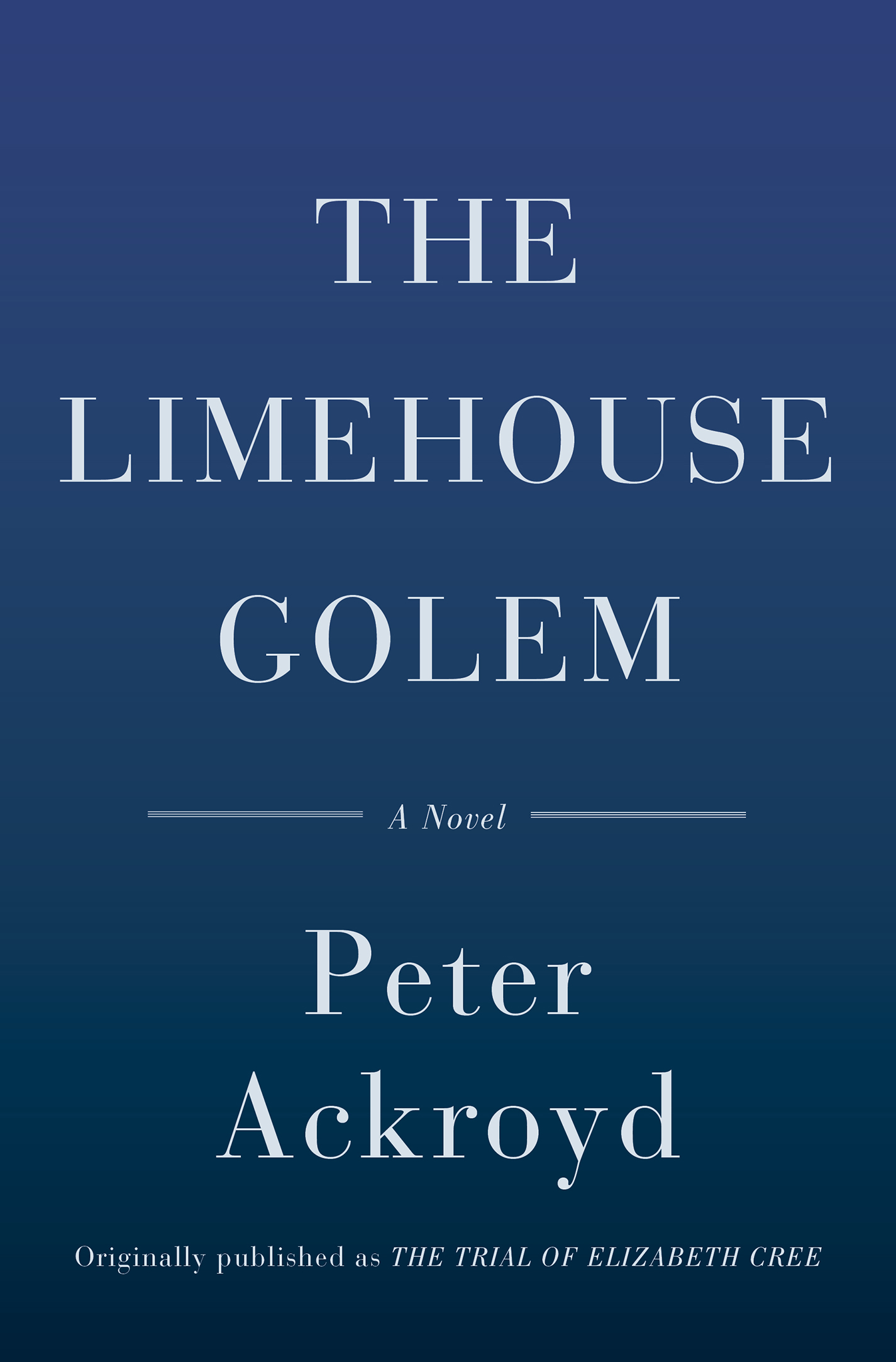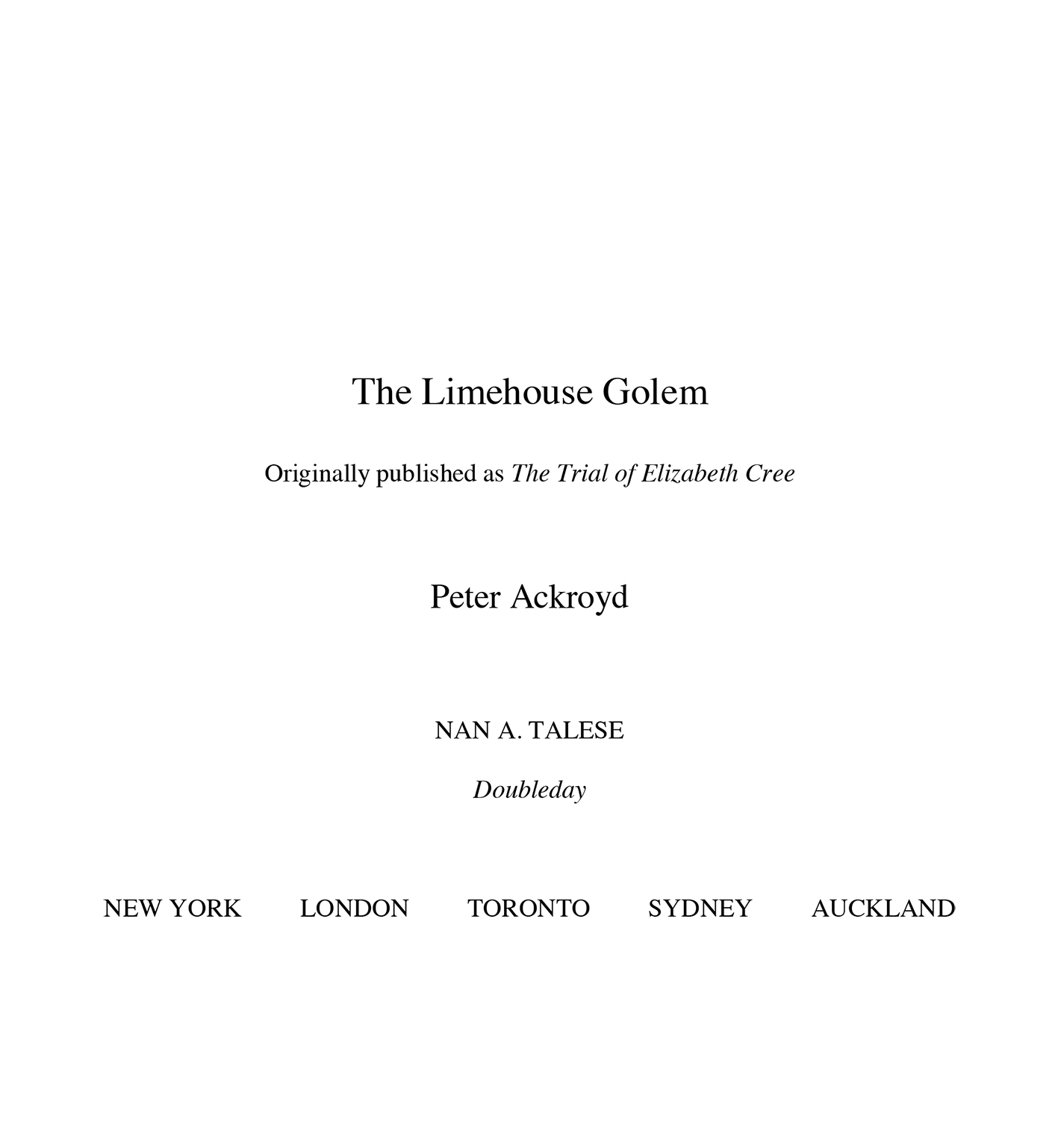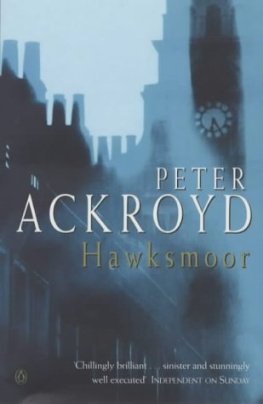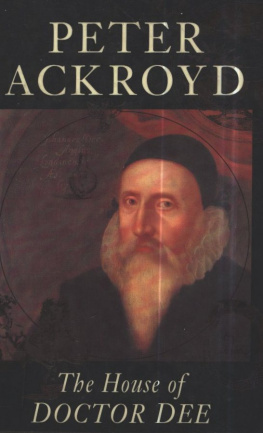Ackroyd - The Limehouse Golem
Here you can read online Ackroyd - The Limehouse Golem full text of the book (entire story) in english for free. Download pdf and epub, get meaning, cover and reviews about this ebook. year: 2012;1994, publisher: Knopf Doubleday Publishing Group, genre: Detective and thriller. Description of the work, (preface) as well as reviews are available. Best literature library LitArk.com created for fans of good reading and offers a wide selection of genres:
Romance novel
Science fiction
Adventure
Detective
Science
History
Home and family
Prose
Art
Politics
Computer
Non-fiction
Religion
Business
Children
Humor
Choose a favorite category and find really read worthwhile books. Enjoy immersion in the world of imagination, feel the emotions of the characters or learn something new for yourself, make an fascinating discovery.

- Book:The Limehouse Golem
- Author:
- Publisher:Knopf Doubleday Publishing Group
- Genre:
- Year:2012;1994
- Rating:4 / 5
- Favourites:Add to favourites
- Your mark:
- 80
- 1
- 2
- 3
- 4
- 5
The Limehouse Golem: summary, description and annotation
We offer to read an annotation, description, summary or preface (depends on what the author of the book "The Limehouse Golem" wrote himself). If you haven't found the necessary information about the book — write in the comments, we will try to find it.
Ackroyd: author's other books
Who wrote The Limehouse Golem? Find out the surname, the name of the author of the book and a list of all author's works by series.
The Limehouse Golem — read online for free the complete book (whole text) full work
Below is the text of the book, divided by pages. System saving the place of the last page read, allows you to conveniently read the book "The Limehouse Golem" online for free, without having to search again every time where you left off. Put a bookmark, and you can go to the page where you finished reading at any time.
Font size:
Interval:
Bookmark:

fiction
The Great Fire of London
The Last Testament of Oscar Wilde
Hawksmoor
Chatterton
First Light
English Music
The House of Doctor Dee
The Limehouse Golem
biography
T.S. Eliot
Dickens
poetry
The Diversions of Purley
criticism
Notes for a New Culture

Published in the United States by Nan A. Talese/Doubleday, a division of Penguin Random House LLC, New York.
DOUBLEDAY is a registered trademark of Penguin Random House LLC. Nan A. Talese and the colophon are trademarks of Penguin Random House LLC.
This novel is a work of fiction. Any references to historical events; to real people, living or dead; or to real locales are intended only to give the fiction a setting in historical reality. Other names, characters, places, and incidents are the product of the authors imagination or are used fictitiously, and their resemblance, if any, to real-life counterparts is entirely coincidental.
Originally published in hardcover in Great Britain as Dan Leno and the Limehouse Golem by Sinclair-Stevenson Ltd, London, in 1994, and subsequently in hardcover as The Trial of Elizabeth Cree by Nan A. Talese/Doubleday, a division of Penguin Random House LLC, New York, in 1995.
Library of Congress Cataloging-in-Publication Data
Ackroyd, Peter.
The Limehouse Golem : a novel of the Limehouse murders / Peter Ackroyd.
p. cm.
I. Title.
PR6051.C64T7 1995
823.914dc2094-37348
eISBN: 978-0-307-81623-8
Copyright 1994 by Peter Ackroyd
All Rights Reserved
v3.1_r1
O n the 6th April, 1881, a woman was hanged within the walls of Camberwell Prison. The ceremony was to be performed at eight oclock, according to custom, and just after dawn the other prisoners began their ritual howling. The death bell of the prison chapel tolled as she was led from the condemned cell and joined a procession which included the governor, the prison chaplain, the prison doctor, the Roman Catholic priest, who had heard her confession the night before, her solicitor, and two witnesses appointed by the Home Office. The public executioner was waiting for them in a wooden shed across the yard where a gallows had been erectedonly a few years before the woman could have been hanged beside the walls of Newgate Prison, to the delight of the vast crowd assembled there throughout the night, but the chance of such a great performance had been denied her by the progressive legislation of 1868. So she had to die in mid-Victorian privacy, in a wooden shed that smelled of the sweat of the workmen who had erected it two days earlier. The only tribute to sensationalism was her coffin, which had been strategically placed in the prison yard so that she might pass it on the way to her death.
The Burial Office was read, and it was noticed that she participated in this with great fervor. The condemned are supposed to remain quite silent at this solemn time but she lifted her head and, staring through the little roof of glass at the foggy air beyond, begged loudly for the safety of her own soul. The customary incantation came to an end, and the hangman stood behind her as she climbed the wooden block; he was about to place the coarsely woven cloth over her, but she brushed it away with the motion of her head. Her hands had already been bound behind her back with leathern thongs, but there was no difficulty in interpreting the gesture. While she stared down at the official witnesses, the rope was placed around her neck (the executioner, knowing her precise size and weight, had measured the hemp exactly). She spoke only once before he pulled the lever and the wooden trapdoor opened beneath her. She said, Here we are again! Her eyes were still upon them as she fell. Her name was Elizabeth Cree. She was thirty-one years old.
She had been wearing a white smock, or gown, at the moment of her deliverance. It had been the custom, during the days of public execution, for the dress of the dead to be torn apart and sold in pieces to the assembled crowd as mementos or magical talismans. But this had become an age of private possessiveness, and the white gown was taken from the body of the hanged woman with great reverence. Later that day it was handed to the governor of the prison, Mr. Stephens, who accepted it without a word from the female warder who carried it to his office. He did not need to inquire about the body itself; he had already agreed that it should be dispatched to the medical surgeon of Limehouse Division, who specialized in examining the brains of murderers for any signs of abnormality. As soon as the warder had closed the door behind her, Mr. Stephens folded the white gown very neatly and placed it in the Gladstone bag which he kept behind his desk. That night, in his small house on Hornsey Rise, he took it carefully from the bag; he lifted it above his head, and put it on. He was wearing nothing else and, with a sigh, he lay down upon the carpet in the gown of the hanged woman.
W ho now remembers the story of the Limehouse Golem, or cares to be reminded of the history of that mythical creature? Golem is the medieval Jewish word for an artificial being, created by the magician or the rabbi; it literally means thing without form, and perhaps sprang from the same fears which surrounded the fifteenth-century concept of the homunculus which was supposed to have been given material shape in the laboratories of Hamburg and Moscow. It was an object of horror, sometimes said to be made of red clay or sand, and in the mid-eighteenth century it was associated with specters and succubi who have a taste for blood. The secret of how it came to be revived in the last decades of the nineteenth century, and how it aroused the same anxieties and horrors as its medieval counterpart, is to be found within the annals of Londons past.
The first killing occurred on the 10th September, 1880, along Limehouse Reach: this, as its name implies, was an ancient lane which led from a small thoroughfare of mean houses to a flight of stone steps just above the bank of the Thames. It had been used by porters over many centuries for convenient if somewhat cramped access to the cargo of smaller boats which anchored here, but the dock redevelopments of the 1830s had left it marooned on the edge of the mud banks. It reeked of dampness and old stone, but it also possessed a stranger and more fugitive odor which was aptly described by one of the residents of the neighborhood as that of dead feet. It was here, at first light on a September morning, that the body of Jane Quig was discovered. She had been left upon the old steps in three separate parts; her head was upon the upper step, with her torso arranged beneath it in some parody of the human form, while certain of her internal organs had been impaled upon a wooden post by the riverside. She had been a prostitute who had found her custom among the sailors of the area and, although she was only in her early twenties, had been known to her neighbors as Old Salty. Of course the popular opinion, inflamed by gruesome reports in the Daily News and Morning Advertiser, declared that a fiend in human form was at worka supposition which was strengthened when, six nights later, another killing took place in the same area.
Font size:
Interval:
Bookmark:
Similar books «The Limehouse Golem»
Look at similar books to The Limehouse Golem. We have selected literature similar in name and meaning in the hope of providing readers with more options to find new, interesting, not yet read works.
Discussion, reviews of the book The Limehouse Golem and just readers' own opinions. Leave your comments, write what you think about the work, its meaning or the main characters. Specify what exactly you liked and what you didn't like, and why you think so.
















